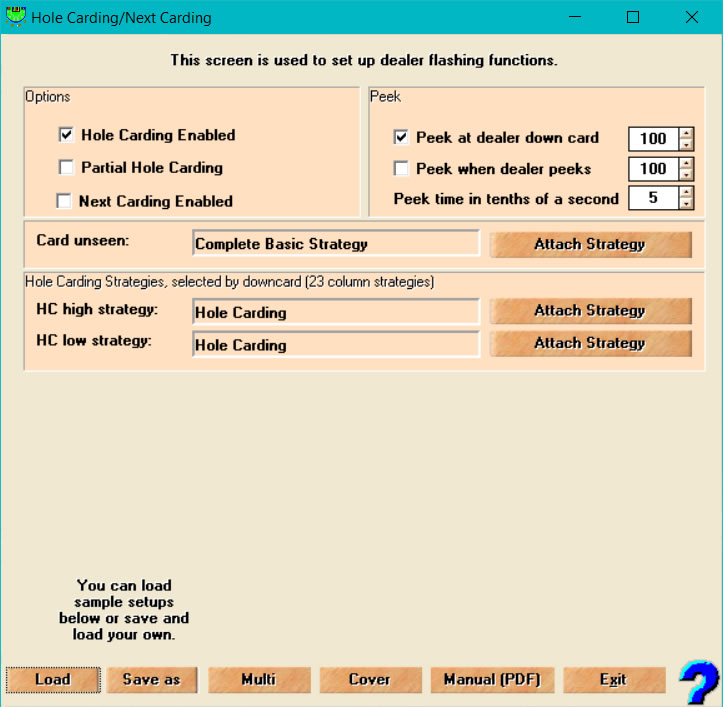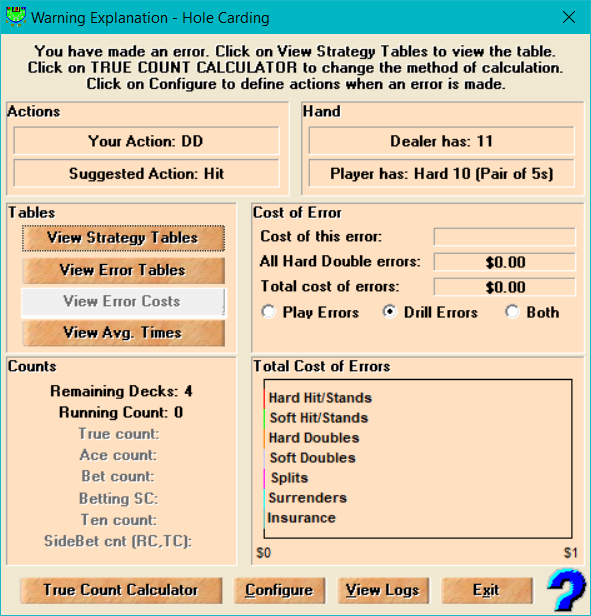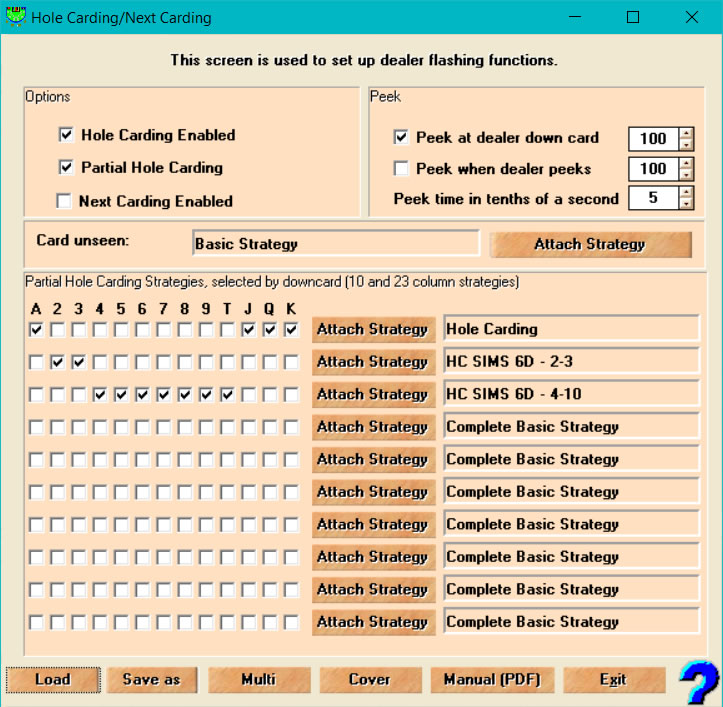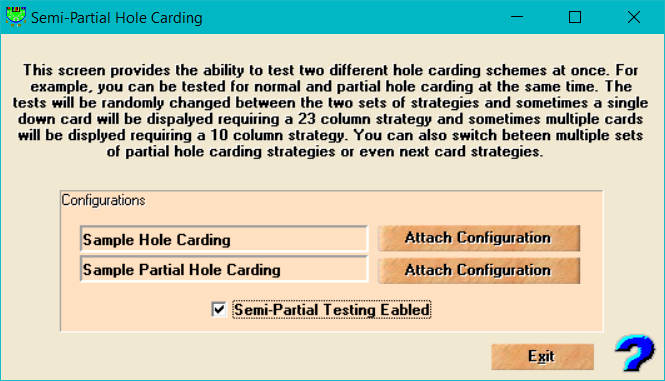CVHoleCard
CVHoleCard is an add-in to Casino Verite Blackjack that deals with flashed cards. That is, cards that a sloppy dealer momentarily fails to hide from view. This add-in supports hole carding, partial hole carding, next carding, partial next carding, and simultaneous mixtures of these.
There are several tasks required for the successful use of flashed cards. Among them:
- Determination of strategies
- Calculation EV, risk, etc.
- Scouting tables
- Determining the flashed card (which may include a partner)
- Practice and cover play
The first two are included in CVData. This add-in covers practice and cover play. Determining the flashed card is a difficult skill and the less said about this in public, the better. Practice can be difficult for partial hole carding as the strategies are not intuitive.
Hole Carding
Hole carding (observing the dealer’s hole card) practice is supported in the game and the flashcard drills. The first task is to set the parameters. You can reach the following screen from the game menu:Strategies-Hole Carding, or from the main page in the Drills using the Hole Carding button.

On the bottom left, you will find Save and Load buttons. You can save and load your configurations. You can also load included samples. You can click Load and select the Sample Hole Carding file to load the above setup. Or, at the top left, select Hole Carding Enabled for simple hole carding. On the right, select the percentage of times you see the card. You can also set the flash time. This is not meant to be realistic. Just set it to a time that you find convenient. Again, the software is not designed to help you determine the card, only to practice playing strategies.
Next, you set the strategies. Two types of strategies are supported, ten column and 23 column. Ten column strategies are the normal type with an upcard of ace through ten. 23 columns are required when you know both the upcard and specific downcard. We see three strategies here. The first is the strategy used when you don’t see the downcard and must be 10 column. Click Attach Strategy to change the strategy. Next are the hole carding tables and must be 23 column. They can be the same or different. The first is used when the upcard is an ace, 7, 8, 9, or ten valued card and second for other upcards. It does not look good to split tens against a ten up. You can create new strategies to customize cover play to avoid giveaways. Or, you can use the Cover Plays button at the bottom. When you click Attach Strategy, only 23 column strats will be displayed. Samples are included in folder Norm Wattenberger/QFIT, subfolder Hole Card/Next Card. You can also display the tables in the Attach dialog and one strategy can include single and multiple deck, H17 and S17 tables. The tables in memory will be adjusted according to the game settings.
Normally, players do not count cards while using these methods. However, it is supported. Set the Card Unseen strategy to the counting strategy. The counting method from that strategy will be used. Indices from all strategies are used.
You can specify more detail with partial hole carding.
Cover Play
Instead of adjusting the tables yourself, you can click the Cover Plays button:

The seven tabs start by displaying the HC strategy specified for a dealer high upcard with adjustments in the tables for current rules. Fourteen cover plays are included. When you turn an option on or off, you will immediately see the changes to the tables. Changing the options will also switch the tabs to the affected table, and if the cover play is for a low upcard, switch the strategy according to your settings. This does not change the strategy on disk. It will change it in memory whenever any 23 column strategy is loaded, differently for high and low upcards. After you exit, the Save button on the Hole Card screen will save these options. They will also be automatically saved in the configuration for the current user. Note, only 23 column strategies are affected. Partial HC tables will not use these options.
Note: These are the EV losses assuming six decks and observing the card 100% of the time. The actual penalty would be much less. HC and LC stand for high and low upcard.
Cover Play |
Loss |
Do not hit hard 18, 19 |
1.0% |
Do not hit hard 17 |
1.2% |
Do not hit A8 against 20 |
0.08% |
Split 88 with dealer 10, 11 against LC |
>.01% |
Do not split TT against HC |
0.2% |
Do not split TT against LC |
0.1% |
Do not split 99 against HC |
0.05% |
Do not split 44 against 13 HC |
>.01% |
Do not soft double against Ace up |
0.01% |
Do not soft double A9 against HC |
0.02% |
Do not double 10 against Ace up |
0.01% |
Do not double 5-9 against HC |
0.46% |
Do not double 5-6 against LC |
0.02% |
Do not hit 14-16 against LC |
0.22% |
The Game
All of the normal hundreds of game options are supported. When you play, the downcard will be flashed. (Again, no attempt is made to show part of a card.) The correct tables will be used as per your rules settings. If you make an error, an error screen will pop up:

Click Configure to change how errors are handled. If you then click View Strategy tables, you will see your error with a blinking cell: Cost of errors is not supported for CVHC.

Clicking Errors will show you all your accumulated errors, but make sure you have the Display options at the bottom middle set correctly.

You will note that the bottom right shows all currently active strategies. The list can be lengthy when next carding. You can click on a strategy to see your errors for that strategy or click one of the first two to see a sum of all ten column or 23 column strats that are currently active. For the drills, you can also see the average time taken for each decision. You can exit this screen, and click View logs to see all your errors:

The error logs have been expanded to deal with separate strategies in use at the same time and mixed 10 column and 23 column practice. Click a View cell to see the associated strategy table with a blinking cell telling you where the error took place.
Note: The error counts and error logs can also be displayed in the game from the History menu or the main drills page in the Statistics box. You will note the standard blue ? in many tables for screen help.
Also, you can select File-Last Error after you complete a hand to display the cards and error.
Drills
Only Flashcard drills are supported:

Most of the standard options are supported, except for Mask and all situations are always on. If you have Default Hands selected, the two HC strategies are analyzed and a list of hands that look like they are non-trivial will be selected for possible tests. If you select Drill and or Play Errors, you will be tested for errors you have made in the past, and sometimes, hands near your errors. Click Launch to start the drill.

The downcard is displayed above the test buttons. Click a test button for the correct play. An error will take you to the error screen discussed earlier. After an error, click the highlighted test button to continue. You may set options to display two to five cards or a variable number of cards as well as speeds.
Partial Hole Carding
Back to the setup screen:

Here is a simple partial hole carding setup. Partial HC is used when you get a glimpse of a card, but don’t know the exact value. To set this, turn on Partial Hold Carding or load the sample. Note: This sample is not meant to be a normal set up. Here, you can intermix 10 and 23 column strats. You specify the strategies as usual, and select the dealer downcards used for each strategy in the array of option boxes. In this setup, basic strategy is used when the card is not seen. A 23 column HC strategy is used with AJQK. Two 10 column strategies are used for the other possible downcards. Partial HC is only used in the drills, not the game.
During the drill, the downcard can now be multiple cards. For example, if the downcard is a 5 in this setup, 456789T is displayed in the Downcard box as you are not certain of the value. If you get an error, the error screen and View Strategy screen will display which strategy was violated at the top and the violated strategy will be displayed. The error logs will also display the violated strategy.
There are 18 sets of partial hole carding tables included, each for both dealer hits soft-17 and hard-17. The double and six deck tables assume double after split allowed and the single deck does not. The single deck tables assume dealer can double any original two card hand. Slightly more Las Vegas have a D10 rule limiting doubles. But, these tables will be automatically changed in memory if that rule is set. Note: There are slight differences from the tables in Modern Blackjack as the assumptions are slightly different. Additional tables can be generated with CVData. Note: There are many extremely close plays. The CVData tables select the least risky play in very close decisions.
If you use the Default hands option in the drills, all active 10 card strategies will be analyzed for a set of possible tests.
Next Carding
With Next Carding, you know the next card to be dealt. As this drill is about playing, not betting, it is assumed you already have a hand, which can be 2 to 5 cards. The player hand, dealer upcard, and next card are displayed. The Next carding and partial next carding screens look much the same: Here, only ten column strategies are supported. If you want to include partial next carding, this is done in the same manner as with partial hole carding.
There are three types of next carding tables:
- Third base means that if you don’t take the next card, the dealer will get it. Use these tables for heads-up against the dealer.
- First base means that someone else will get it.
- If you are at third base and the game is no hole card; then if you don’t take a card, it may be drawn as the dealer second card. This is very different. Suppose the dealer has a ten up and the next card is a ten. If you stand, in a no hole card game, the dealer will have a 20. But if there is a hole card, the dealer will only draw the ten if she has a stiff. So it busts the dealer.
Some tables are included in the Wattenberger/QFIT/holecarding folder. All of these can be generated with CVData.

Multi-Test
Suppose at the same table, sometimes you know the downcard is a 5, but other times you only know it is a 4, 5, or 6. You can gain extra precision by using a 23 column strategy in the first incidence and a 10 column strategy in the second. This screen provides the ability to test two different hole carding schemes at once. For example, you can be tested for normal and partial hole carding at the same time. The tests will be randomly changed between the two sets of strategies and sometimes a single downcard will be displayed requiring a 23 column strategy and sometimes multiple possible downcards will be displayed requiring a 10 column strategy. You can also switch between multiple sets of partial hole carding strategies or even next card strategies for a serious workout.
Click the Multi button on the Hole Carding screen to see this screen. Attach two sets of strategies and turn on Semi-Partial Testing Enabled.
This function is currently only enabled for drills. When the FlashCard drill is set to Default hands, all strategies in both strategy sets will be analyzed to create a list of tests. If you set the hands to previous errors, you will be tested for errors made when using both sets of strategies.

Future
There are several possible additions that could be made to these functions. We’ll see what the interest is.
Demo/Purchase
For a demo:
If you do not have Casino Verite Blackjack installed, install the full demo at: www.qfit.com/downloads.htm.
If you have CV Blackjack V5.5 or higher, install the update at: www.qfit.com/downloads.htm#free.
You can purchase at: www.qfit.com/orders.htm.
| 
